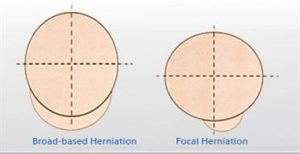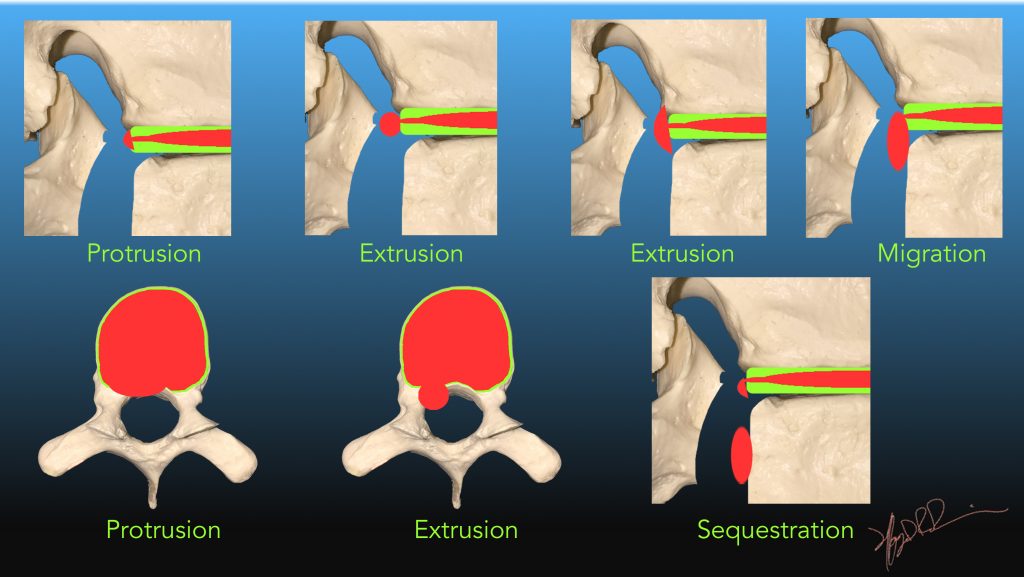
However when thoracic disc bulges do occur they can be just as problematic as any other type of disc abnormalities if not more so. A disc bulge is a word commonly used to describe a slight outpouching of the disc.

In simple terms a disc bulge refers to an apparent generalized extension of disc tissues beyond the edges of the edge of vertebrae usually less than 3mm.
Broad based disc bulge. A broad-based disc protrusion occurs when more than 25 percent but less than 50 percent of the disc materials circumference is extended beyond the spinal bone borders according to the American Journal of Neuroradiology. A disc is bulging when over 50 percent of the disc materials circumference is overextended. What is a disc bulge.
It is a condition wherein a part of the disc extends beyond the normal limits and the internal part of the disc remains intact in the fibrous ring. The bulging is always broad thus the term broad based disc bulge. Broad based bulging discs are not any inherently worse than focal protrusions.
Most broad based disc protrusions are not symptomatic or harmful in any way although some may enact pain and possible related symptoms if they affect a neurological structure. Broad based central herniated discs are often reported to impinge on the thecal sac which basically amounts to nothing. In simple terms a disc bulge refers to an apparent generalized extension of disc tissues beyond the edges of the edge of vertebrae usually less than 3mm.
Bulge is a term for an image and can be a normal variant usually at L5-S1. Asymmetric disc bulge Broad-based disc bulge. The bulge involves 25 to 50 of the discs circumference.
Circumferential Disc Bulge Circumferential disc bulge Diffuse disc bulge. The bulge extends beyond the entire disc circumference. A disc bulge represents displacement of the outer fibers of the annulus fibrosus beyond the margins of the adjacent vertebral bodies involving more than one-quarter 25 or 90 degrees of the circumference of an intervertebral disc 3.
Because it is limited by the annulus fibrosus it does not extend above or below the attached margins of the disc 3. Had a Cervical MRI done and here are the resultsC34- Minimal Broad based disc bulge. C45-Mild broad based disc bulge slightly asymmetric to the right.
C56-Disc space height is diminished. Mild disc bulge osteophyte complex is present with bilateral uncinated process hypertrophy Left is greater then Right. Moderate Left and mild to moderate Right foraminal narrowing.
The causes of L4-L5 bulging disc. Its important to know the mechanics of your spinal column and what is happening during a disc bulge so you can embark on the proper treatment with your spine doctor. Your spine is made up of a column of bones stacked on top of each other.
Discs provide cushioning between each of these bones said Livestrong. Sometimes discs may bulge move out of place and put pressure on nerves that exit your spine. Disks show signs of wear and tear with age.
Over time disks dehydrate and their cartilage stiffens. These changes can cause the outer layer of the disk to bulge out fairly evenly all the way around its circumference so it looks a little like a hamburger thats too big for its bun. Over time the discs in the spine undergo wear and tear due to repetitive movements.
This process is absolutely normal and is a part of aging and happens with everyone. L5-S1 bulging discs are most common as they take the stress and weight of the body. The symptoms experienced in the lower back can be terribly painful.
A bulging disc on the other hand can involve more than 180 degrees of the discs circumference. This means protruding discs may be viewed as potentially more serious than bulging discs because with protrusion more pressure is placed on a smaller area of the disc. This could extend the protrusion farther into the central spinal canal or a nerve root exit.
Diagnosing broad disc protrusion. You could have a protruding disc and not even realize it. Broad based left paracentral lateral protrusion of the L5S1 intervertebral disc is seen abutting the ipsilateral traversing S1 nerve.
Disc bulge is seen at L4L5 with posterocentral dominancepartly effacing the ipsilateral laterak recess and mildly encroaching on the ipsilateral inferior neral foramen. A thoracic bulging disc is the least often seen type of intervertebral protrusion since the middle and upper back spinal regions are far less likely to develop herniated discs. However when thoracic disc bulges do occur they can be just as problematic as any other type of disc abnormalities if not more so.
Interpret-pleasemild broad-based disc bulge l5-s1 may contact s1 nerve root emerging from dural sac. 2 nerve roots dont appear compressed. A posterior bulging disc or herniated disc occurs when a spinal disc beings to bulge.
A posterior bulging disc also known as a herniated disc occurs when a spinal disc that sits between vertebrae begins to bulge due to compression. This condition can be painful. A disc bulge is a word commonly used to describe a slight outpouching of the disc.
The words disc bulge imply that the disc appears symmetric with a small amount of outpouching and no significant herniation. Specifically disc bulges do not penetrate the ligament barrier that separates the disc from the spinal canal. Most often a trip to see your doctor and discuss your experienced C5-C6 disc bulging symptoms would result in a physical exam imaging tests and neurological testing.
Diagnostic image testing such as magnetic resonance imaging MRI andor a computed tomography scan CT will show a bulging disc where it is located and how severe it is. Treatment for a disc bulge in L4-L5 includes physical therapy and waiting to see if symptoms abate on their own or a surgical repair. The majority of bulging discs occur in the lumbar or lower region of the spine.
Non-surgical treatments can be used to alleviate the pain while the patient waits for symptoms to go away on their own. Disc bulge is responsible for the height of the disc that has been lost due to aging. Disc bulge is distinguished from herniated disc as in herniated disc it involves only below 25 of the circumference.
Disc bulge is a very common injury which sustains to the spinal cords intervertebral disc. Disc bulge is a projection into spinal canal or foramina of soft gelatinous nucleus pulposus with intact fibrous annulus covering of the disc. Lumbar foramina is a lateral bony tunnel meant to pass the spinal nerve and lumbar spinal canal accommodates lower end of spinal cord and quada equina see Figure 2.
Quada equina is a. C4-c5 mild broad based disc bulge without foraminal narrowing or canal stenosis. C5-c6 mild broad-based disc bulge with mild left greater than right uncovertebbral degenerative change and moderate facet arthropthy is seen with minimal bilateral foraminal narrowing and minimal narrowing of the csf space anterior to the cord.
A disc is protruded if the greatest plane in any direction between the edges of the disc material beyond the disc space is less than the distance between the edges of the base when measured in the same plane. Protrusions may be focal or broad-based Fardon Milette 2001 pE100.